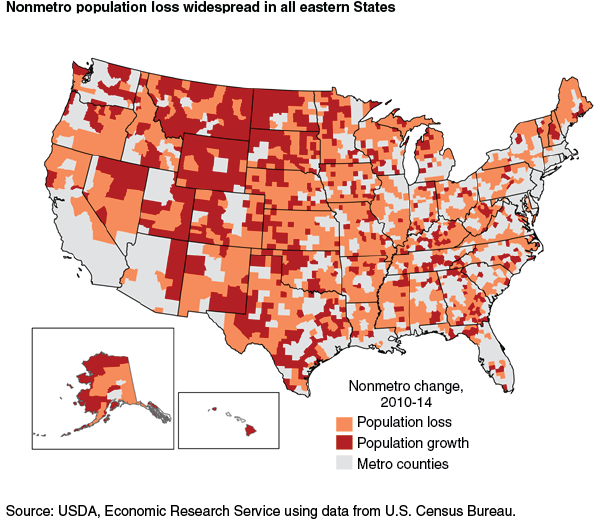Population Loss in Nonmetro Counties Continues
- by John Cromartie
- 8/3/2015
The number of people living in nonmetropolitan (nonmetro) counties stood at 46.2 million in 2014, representing nearly 15 percent of U.S. residents spread across 72 percent of the Nation's land area. Nonmetro areas lost population between July 2013 and 2014, continuing a 4-year trend. While hundreds of individual nonmetro counties have lost population over the years, this is the first recorded period of overall population decline. The recent economic recession, increased global competition, and technological changes led to widespread job losses in rural manufacturing and have contributed to the nonmetro population decline since 2010. Also, suburban expansion and migration to scenic retirement/recreation destinations have weakened since 2010.
In the past, population loss was concentrated in the Great Plains and extended into Corn Belt areas of Midwestern States. Population loss also historically occurred in areas of relatively high poverty in the southern Coastal Plains and in Appalachia. New geographic patterns since 2010 extend population loss throughout the eastern half of the United States, especially in manufacturing-dependent regions such as along the North Carolina-Virginia border and southern Ohio. The housing mortgage crisis slowed suburban and exurban development in nonmetro counties near metro areas, considerably reducing the number of adjacent nonmetro counties experiencing population growth.
Not all nonmetro counties have lost population since 2010. Approximately 700 nonmetro counties had population increases, together adding over 400,000 residents. New growth patterns have emerged in post-recession years. Population growth continued in most areas of the Mountain West but slowed considerably for the first time in decades. Numerous recreation-dependent counties in Oregon, Idaho, Nevada, and elsewhere switched from relatively rapid growth before the housing mortgage crisis to decline during 2010-14. At the same time, large sections of the northern Great Plains started gaining population after decades of persistent population decline, due largely to in-migration of workers during the shale oil and gas production boom. Other nonmetro regions, such as southeastern New Mexico and parts of eastern Texas, also experienced population gains from energy-related job growth.
This article is drawn from:
- Population & Migration. (n.d.). U.S. Department of Agriculture, Economic Research Service.


